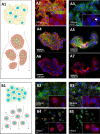Microfluidic-based prostate cancer model for investigating the secretion of prostate-specific antigen and microRNAs in vitro
- PMID: 37468746
- PMCID: PMC10356943
- DOI: 10.1038/s41598-023-38834-y
Microfluidic-based prostate cancer model for investigating the secretion of prostate-specific antigen and microRNAs in vitro
Abstract
The study of prostate cancer in vitro relies on established cell lines that lack important physiological characteristics, such as proper polarization and expression of relevant biomarkers. Microphysiological systems (MPS) can replicate cancer microenvironments and lead to cellular phenotypic changes that better represent organ physiology in vitro. In this study, we developed an MPS model comprising conventional prostate cancer cells to evaluate their activity under dynamic culture conditions. Androgen-sensitive (LNCaP) and androgen-insensitive (PC3) cells were grown in conventional and 3D cultures, both static and dynamic. Cell morphology, the secretion of prostate-specific antigen, and the expression of key prostate markers and microRNAs were analyzed. LNCaP formed spheroids in 3D and MPS cultures, with morphological changes supported by the upregulation of cytokeratins and adhesion proteins. LNCaP also maintained a constant prostate-specific antigen secretion in MPS. PC3 cells did not develop complex structures in 3D and MPS cultures. PSA expression at the gene level was downregulated in LNCaP-MPS and considerably upregulated in PC3-MPS. MicroRNA expression was altered by the 3D static and dynamic culture, both intra- and extracellularly. MicroRNAs associated with prostate cancer progression were mostly upregulated in LNCaP-MPS. Overall dynamic cell culture substantially altered the morphology and expression of LNCaP cells, arguably augmenting their prostate cancer phenotype. This novel approach demonstrates that microRNA expression in prostate cancer cells is sensitive to external stimuli and that MPS can effectively promote important physiological changes in conventional prostate cancer models.
© 2023. The Author(s).
Conflict of interest statement
The authors declare no competing interests.
Figures







Similar articles
-
Correlation of Sprouty1 and Jagged1 with aggressive prostate cancer cells with different sensitivities to androgen deprivation.J Cell Biochem. 2014 Sep;115(9):1505-15. doi: 10.1002/jcb.24805. J Cell Biochem. 2014. PMID: 24604720 Free PMC article.
-
Distinct Osteomimetic Response of Androgen-Dependent and Independent Human Prostate Cancer Cells to Mechanical Action of Fluid Flow: Prometastatic Implications.Prostate. 2017 Feb;77(3):321-333. doi: 10.1002/pros.23270. Epub 2016 Nov 3. Prostate. 2017. PMID: 27813116
-
Prostate-specific antigen (PSA) promoter-driven androgen-inducible expression of sodium iodide symporter in prostate cancer cell lines.Cancer Res. 1999 May 1;59(9):2136-41. Cancer Res. 1999. PMID: 10232600
-
Human prostate cancer progression models and therapeutic intervention.Hinyokika Kiyo. 1997 Nov;43(11):815-20. Hinyokika Kiyo. 1997. PMID: 9436028 Review.
-
Sex steroid hormone metabolism and prostate cancer.J Steroid Biochem Mol Biol. 2004 Nov;92(4):281-6. doi: 10.1016/j.jsbmb.2004.10.004. Epub 2004 Dec 19. J Steroid Biochem Mol Biol. 2004. PMID: 15663991 Review.
Cited by
-
Bioengineering methods for vascularizing organoids.Cell Rep Methods. 2024 Jun 17;4(6):100779. doi: 10.1016/j.crmeth.2024.100779. Epub 2024 May 16. Cell Rep Methods. 2024. PMID: 38759654 Free PMC article. Review.
-
Blood vessels in a dish: the evolution, challenges, and potential of vascularized tissues and organoids.Front Cardiovasc Med. 2024 Jun 13;11:1336910. doi: 10.3389/fcvm.2024.1336910. eCollection 2024. Front Cardiovasc Med. 2024. PMID: 38938652 Free PMC article. Review.
-
Microfluidic Applications in Prostate Cancer Research.Micromachines (Basel). 2024 Sep 27;15(10):1195. doi: 10.3390/mi15101195. Micromachines (Basel). 2024. PMID: 39459070 Free PMC article. Review.
-
Autonomous Nucleic Acid and Protein Nanocomputing Agents Engineered to Operate in Living Cells.ACS Nano. 2025 Jan 21;19(2):1865-1883. doi: 10.1021/acsnano.4c13663. Epub 2025 Jan 6. ACS Nano. 2025. PMID: 39760461 Free PMC article. Review.
-
SARS-CoV-2 Spike Protein Amplifies the Immunogenicity of Healthy Renal Epithelium in the Presence of Renal Cell Carcinoma.Cells. 2024 Dec 10;13(24):2038. doi: 10.3390/cells13242038. Cells. 2024. PMID: 39768130 Free PMC article.
References
-
- Bedke J, et al. The 2021 updated European association of urology guidelines on renal cell carcinoma: Immune checkpoint inhibitor–based combination therapies for treatment-naive metastatic clear-cell renal cell carcinoma are standard of care. Eur. Urol. 2021;80:393–397. doi: 10.1016/j.eururo.2021.04.042. - DOI - PubMed
Publication types
MeSH terms
Substances
LinkOut - more resources
Full Text Sources
Medical
Research Materials
Miscellaneous

